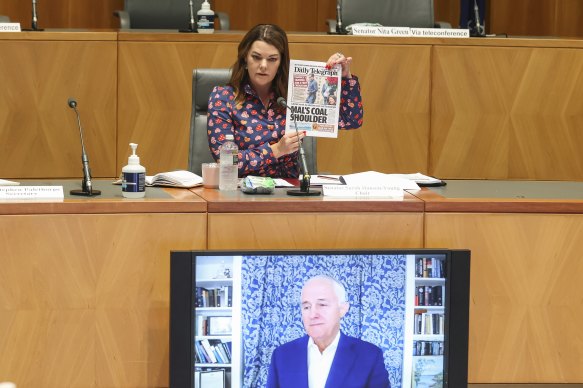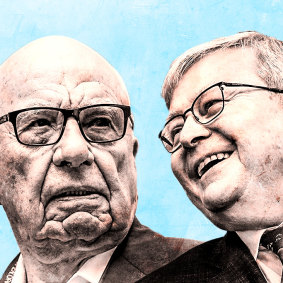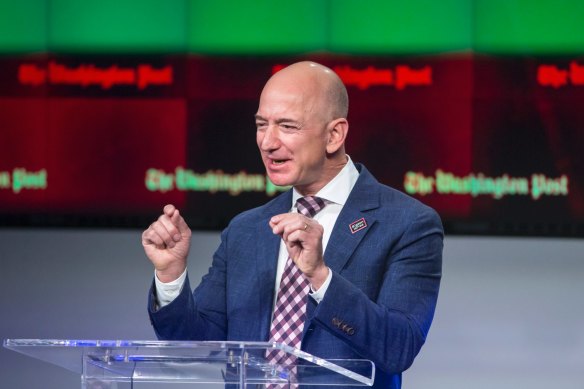This was published 3 years ago
Opinion
Australia needs more media diversity – and there are ways to achieve it
Bruce Guthrie
Sunday Age columnistOn Monday, while I waited to appear at the Senate inquiry into media diversity in Parliament House, Canberra, Malcolm Turnbull was skewering News Corp with all the skills he’s acquired in courts of law and houses of parliament. He was a tough act to follow.
The former PM accused News Corp of everything from intimidation to terrorism and said they’d gone from being a traditional news organisation to a political party, adding: “But a party with only one member.”

Former PM Malcolm Turnbull gives evidence at a Senate inquiry into media diversity, chaired by Sarah Hanson-Young.Credit: Alex Ellinghausen
He was right, of course. But News Corp’s chilling effect on our public discourse and polity is only half the story.
As I told the inquiry just hours later, another confronting issue, certainly for would-be publishers, is the duopoly that now dominates the news landscape in Australia. News Corp (59 per cent) and Nine Entertainment (23 per cent), owner of The Age and The Sydney Morning Herald, together own more than 80 per cent of the national print readership market.

Kevin Rudd has been a staunch critic of the Rupert Murdoch-owned media.Credit: Stephen Kiprillis
Ironically, this dominance is a direct result of 2017’s ill-advised media changes, which in part broke down ownership restrictions, ushered in by Mr Turnbull’s government.
I helped launch The New Daily, a free online news service, in 2013 and almost from day one we were attacked by a particularly venomous News Corp. Nine’s Australian Financial Review, then operated by Fairfax, was also a frequent critic.
And the attacks keep coming seven years on, usually questioning the site’s ownership by Industry Super Funds, even though they enthusiastically embrace an editorial charter and have been generous in supporting public-interest journalism.
This ongoing hostility towards a new publisher demonstrates not only an unwillingness to share the crumbs of a diminishing cake, but a refusal to accept changes to journalism ownership model.
After all, who would have thought Jeff Bezos would one day own – and resuscitate – The
Washington Post or that a not-for-profit would help save the Australian Associated Press.
The difficulties surrounding Australian start-ups prompted six colleagues and I to petition the media diversity inquiry in the hope they could recommend ways of assisting new publishers.

Amazon founder and Washington Post owner Jeff Bezos talks about the history and character of the Post.Credit: AP
Each of us – Monica Attard (The Global Mail), Eric Beecher (Crikey), Alan Kohler (Business Spectator), Wendy Harmer (Hoopla), Andrew Jaspan (The Conversation), Peter Fray (Politifact) – know all too well just how hard it is to make a go of new digital media.
As we wrote: “Media ownership in Australia resides in too few hands. We all understand that this is unhealthy for any civilised democracy: the research and data are irrefutable.
“To make matters worse, over the last 10 years over 5000 jobs have been lost in the media. That has meant large parts of Australia are no longer reported (or at best under-reported) meaning little or no scrutiny and the loss of the critical watchdog role of the media in a well functioning and accountable democracy.
“There’s no point looking back and trying to undo the consequences – intended or otherwise – of past changes to media laws.
“Instead, if the objective is a more diverse Australian media, we should be seeking to tangibly support independent producers of public interest journalism – existing and new entrants – to help them succeed in the marketplace.”
While there is no magic bullet, there are initiatives government could consider to aid small and medium publishers. These could include, but are not limited to:
- Establish a three-year, matched-dollar-funding program for employing journalists, the biggest single cost of establishing a new media business. If a start-up is prepared to spend $500,000 hiring reporters, providing the site meets agreed criteria, the government would kick in half of it. Grants would be capped.
- Make ABC journalism available free to small and medium-sized publishers through a Creative Commons arrangement, similar to The Conversation.
- Increase and extend support for Australian Associated Press. It would be a disaster if News Corp’s Newswire displaced AAP, which I’ve no doubt is News’ goal.
- Governments, both state and federal, mandate that a percentage of their enormous annual advertising spend go directly to small and medium-sized publishers, including start-ups.
- Give businesses extra tax deductions for marketing dollars spent directly with designated news sites.
- Make donations to designated news sites tax deductible.
I’ve always thought editors should at best have a nodding acquaintance with politicians. So I’m a little uneasy about enlisting their support. But these are desperate times.
As we wrote in our submission: “Journalists like to be at arm’s length from governments because they must, ultimately, hold them accountable; for their part, some politicians undoubtedly feel that fewer journalists and less scrutiny of administrations is a good, not a bad, thing.
“But the state of Australian media diversity is so dire that we believe it demands a collaboration to energise what is, frankly, a dying sector.”
Bruce Guthrie is co-founder of The New Daily and former editor of The Age and the Herald Sun.